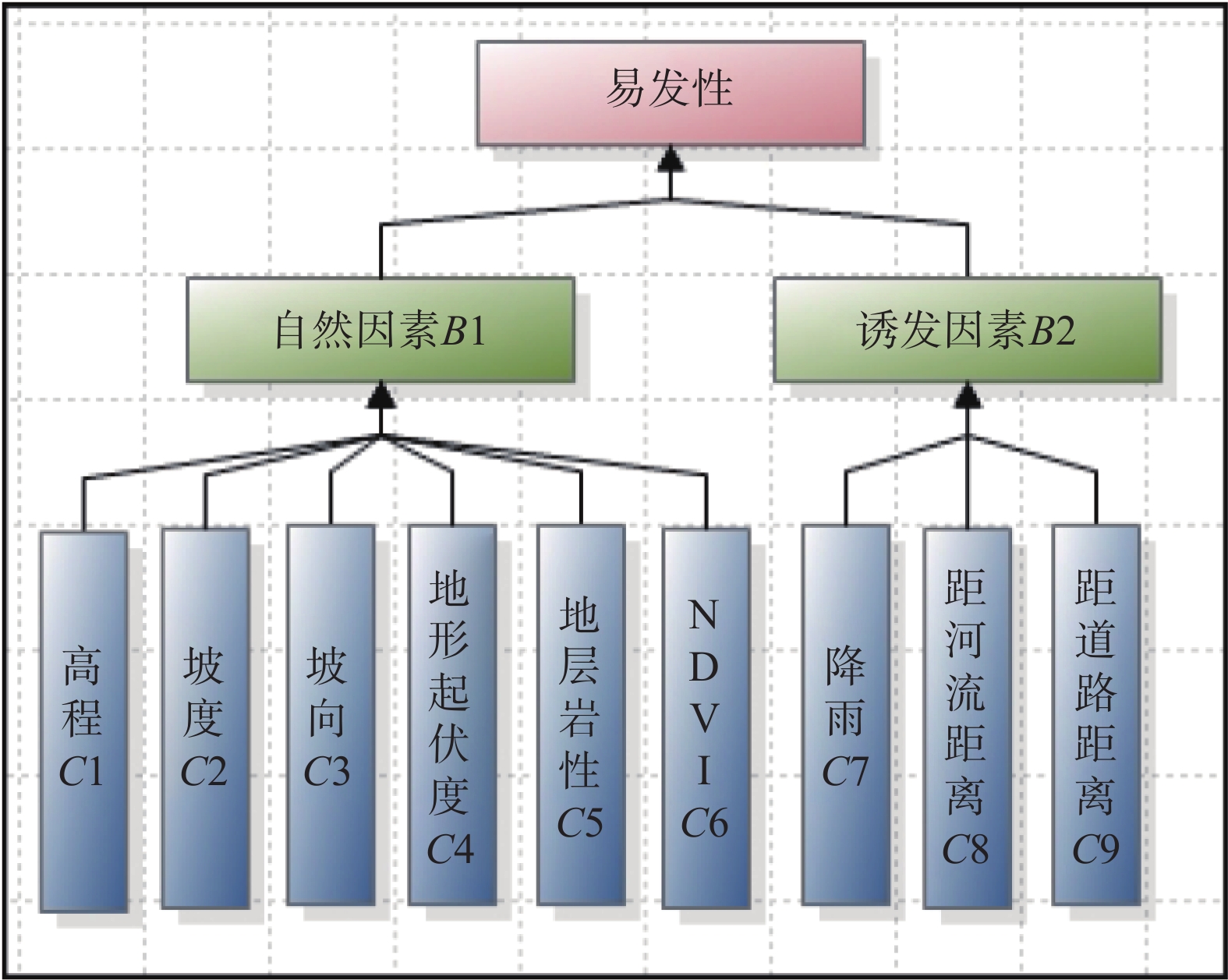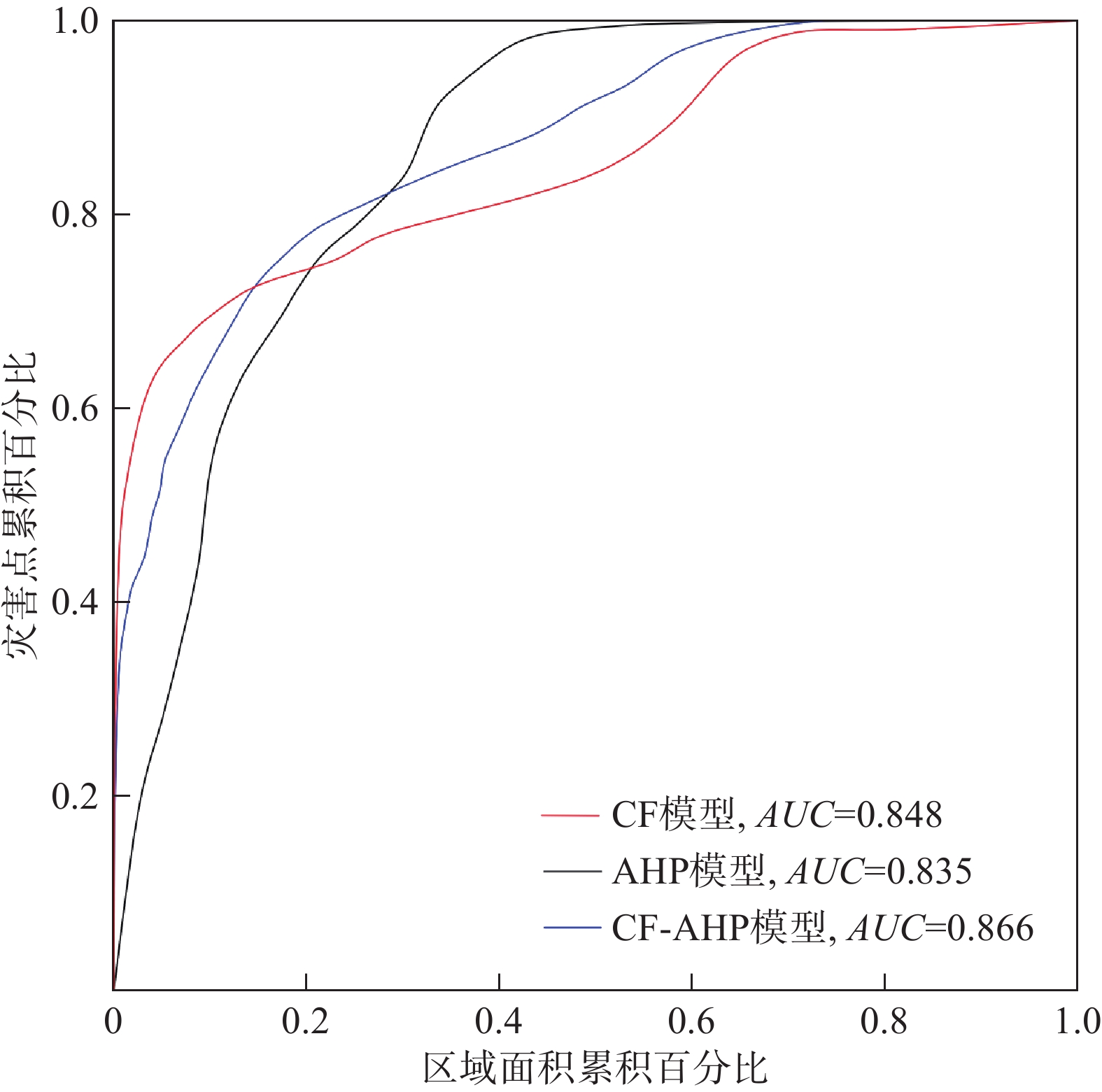Assessment of rockfall susceptibility along the expressway based on the CF-AHP coupling model: A case study of the Tucheng-Wanglong section of the Rongzun expressway
-
摘要: 蓉遵高速公路(土城—旺隆段)沿线崩塌频繁发生,威胁公路安全甚至人类的生命财产安全。文章通过实地调查蓉遵高速公路(土城-旺隆段)崩塌地质灾害的影响因素,构建了9个影响因子,分别是地形起伏度、高程、归一化植被指数、坡向、地层岩性、距道路距离、距河流距离、坡度及降雨量。采用确定性系数模型(certain factors,CF)、层次分析法(analytic hierarchy process,AHP)及耦合模型(CF-AHP)对研究区进行崩塌地质灾害易发性评价,并分别采用崩塌地质灾害点频率统计和成功率曲线对3种模型的评价精度进行检验。结果表明,CF、AHP和CF-AHP的AUC预测精度分别为0.848,0.835,0.866,且3种评价模型得到的崩塌地质灾害的高、中易发区频率比值占总频率比值均超过70%。 3种模型精确度由大到小分别为CF-AHP、CF、AHP模型,说明CF-AHP模型的滑坡预测优于单一的CF、AHP模型,能精确地评价蓉遵高速公路(土城-旺隆段)崩塌地质灾害易发性,为公路沿线区域崩塌灾害的防灾减灾提供决策依据。
-
关键词:
- 崩塌地质灾害 /
- 高速公路 /
- 易发性评价 /
- CF-AHP耦合模型
Abstract: Frequent geological hazards have occurred along the Rongzun Expressway (Tucheng - Wanglong section, posing a threat to the safety of the highway and even human life and property. This study investigated the causes of rockfall along the expressway and identified nine influencing factors, including terrain fluctuation, elevation, normalized difference vegetation index (NDVI), slope direction, lithology, distance from the road, distance from the river, slope, and rainfall. The certainty factor model (CF), analytic hierarchy process (AHP), and coupling model (CF-AHP) were used to evaluate the susceptibility of geological hazard in the study area, and the accuracy of the three models was tested using the distribution of rockfalls at various levels and the success rate curve. The results indicated that the AUC evaluation accuracy of CF, AHP and CF-AHP was 0.848, 0.835 and 0.866, respectively. The frequency ratios of high and moderate prone areas of geohazards obtained by the three evaluation models accounted for more than 70% of the total frequency ratios. The accuracy of the three models in descending order is CF-AHP, CF, AHP models, respectively. This indicates that the CF-AHP model is better than the single CF and AHP models in geohazard prediction and can accurately evaluate the geohazard susceptibility of expressway. It provides a decision-making basis for disaster prevention and mitigation of regional rockfall disaster along the highway. -
0. 引言
对于内部不存在潜在滑移面和控制性结构面的厚层危岩体,其破坏机理十分复杂[1-2]。这种危岩体具有分布区域广、发生频率高、突发性强、破坏范围大等特点,是一类典型的山区地质灾害,对人民生命财产安全和城镇建设造成严重威胁[3-6]。对于涉水厚层危岩体,除了崩塌的直接危害以外,产生的涌浪次生灾害将进一步扩大威胁范围[7-9]。
自2008年三峡库区正式蓄水以来,由于三峡库区水位的周期性涨落,在库岸形成了高达30 m的劣化带[10-12]。库区涉水危岩体的基座部分位于劣化带区域,基座岩体长期处于上部岩体自重下,并在干湿循环作用下逐渐劣化,导致其变形破坏机理更为复杂,进一步加大了危岩体的防治难度[13-15]。
文章在现场调查、监测数据以及室内试验的基础上,分析了三峡库区箭穿洞危岩体的变形破坏特征,并对其破坏模式进行了判定。根据其变形破坏特征,提出了危岩体的治理方案,并采用数值模拟对治理方案进行了定量评价。该危岩体的防护理念对于岩质库岸的防治具有重要的参考价值。
1. 危岩体概况
箭穿洞危岩体位于重庆市巫山县望霞村。危岩体的上游侧边界为纵张裂缝(LF1: 150~226 m);下游侧边界裂缝在陡崖面上清晰可见,上宽下窄,充填或局部充填碎石土或溶蚀、残积碎石土,并向下逐渐收敛至153 m高程尖灭(LF2)。危岩体后缘边界为卸荷裂缝(LF3)张开度可达3.15 m,裂隙在高程226 m以下底部均被碎石所填充。箭穿洞危岩体的正视图见图1。
箭穿洞危岩体的三维切割边界清楚,其几何形态呈不规则的六面体,后缘高程为278~305 m,基座高程为155 m,平均高差为135 m,危岩体平均横宽约55 m,平均厚度约50 m,危岩体体积约36×104 m3,主崩方向为260°。箭穿洞危岩主要为三叠系下统大冶组第四段(T1d4)、高程280 m以上为嘉陵江组第一段(T1j1),基座以下为大冶组第三段(T1d3)。基座岩体位置处有一平硐,其中布有压力传感器。箭穿洞危岩体的典型剖面图见图2。
2. 危岩体的变形特征
由区域地质构造可知,箭穿洞危岩体是在斜坡岩体不断卸荷,长江不断侵蚀切割、构造应力释放等条件下形成的。三维边界基本形成后,重力成为主导危岩体变形的主要因素。另外,干湿循环作用下基座岩体的持续劣化进一步加速了危岩体的变形。根据现场监测资料可知(图3),危岩体的边界裂缝及基座压力随着库水位周期性升降次数的增加而持续增大。
针对基座的泥质条带灰岩,在室内完成了30次干湿循环试验,得到了初始状态、5次、15次、20次以及30次干湿循环后基座岩体的力学参数(表1)。
表 1 泥质条带灰岩力学参数Table 1. Mechanical parameters of marlstone under dry-wet cycles in the Three Gorges Reservoir area干湿循环次数 单轴抗压强度 抗拉强度 /MPa 抗剪强度 变形参数 天然状态/MPa 饱和状态/MPa 内摩擦角/(°) 黏聚力/MPa 弹性模量/(104 MPa) 泊松比μ 0 19.07 13.24 1.10 32.6 3.36 0.405 0.30 5 18.39 12.25 0.99 32.2 3.16 0.373 0.31 15 16.96 11.10 0.89 31.8 2.91 0.351 0.32 20 16.22 10.44 0.83 30.1 2.83 0.272 0.33 30 14.98 9.67 0.79 28.4 2.76 0.238 0.35 经过30次干湿循环后,基座岩体的单轴抗压强度下降约21%~26%,随着循环次数的增加,其强度的劣化率有所下降,但尚未收敛;抗拉强度和黏聚力下降约28%,随着循环次数增加,其劣化率有所下降,趋于收敛;岩石的内摩擦角下降约17%,在15次循环后劣化率有增大趋势,表明岩体的抗剪强度将持续降低;变形参数下降约40%,变形模量趋于减小,泊松比趋于增大,并且在15次循环后劣化率有增大趋势,表明岩体质量将持续降低。
3. 危岩体的失稳破坏模式
根据危岩体的变形特征可知,箭穿洞危岩体以基座的变形破坏为主导,内部不存在潜在的剪切面或导致倾倒变形的控制性结构面。对于这种类型的危岩体,其变形破坏发展一般有2种趋势,分别是基座压裂型崩塌和基座滑移型崩塌[1-2](图4)。
基座压裂型崩塌见图4(a)。如果缓坡岩体较坚硬,基座底部岩体受压集中,会导致基座岩体和接触岩体出现压致拉裂现象;基座破坏时,大量的拉裂缝和剪裂缝会出现,导致岩体整体失稳。基座滑移型崩塌见图4(b)。如果缓坡岩体较为软弱,在上部压力作用下,基座软弱岩体可能会出现剪切破坏,上覆岩体压力将软弱基座挤出,从而发生后靠滑移式的整体破坏。
基座碎裂型崩塌和基座滑移型崩塌的判定与基座岩体强度有关,根据HUNGR等[1]提出的判定方法[1],可采用应力比值(Ns)来界定危岩的破坏模式,Ns的建议值为0.25,其判定公式如下:
(1) 式中:
H——上部危岩体的高度,此处取135 m;
计算可知,Ns为0.63,大于0.25,因而确定箭穿洞危岩体将发生滑移破坏。
4. 危岩体的防护设计
基于箭穿洞危岩体的破坏模式,将危岩体的治理定为两部分,分别是基座软弱岩体的补强加固,以及危岩体中上部的锚索加固(图5)。其中,基座岩体的补强是为了阻断危岩体的滑移剪出;中上部锚索加固是为了控制危岩体的变形。防护治理所涉及的力学改善措施如下:
(1)基座软弱岩体补强加固工程
基座平硐采用C30钢筋混凝土键体充填支撑;基底设置3排锚桩,锚桩间距为1.75 m、2.25 m,锚桩孔径为150 mm,锚固段长度为6.00 m,基座涉水岩体的表面采用板肋式锚杆挡墙。
(2)防护工程(锚索、主动防护网、被动防护网、水下柔性防护垫)
在危岩体中上部布置6排2 000 kN级锚索,水平夹角为15°,水平及竖向间距均为6.00 m,锚索为16 φs15.2 mm,锚固段总长度为17.00 m(3.00,3.00,2.50,3.00,3.00,2.50 m分6段设置)。
5. 防护效果分析
针对防护方案,将提高岩体稳定性的防护措施进行简化后,进行有限元数值计算(所采用数值软件为MIDAS GTS),涵盖上部危岩的预应力锚索、消落带区域砂浆锚杆、板肋式锚杆挡墙及平硐充填。未进行防护加固时,平硐区域作隧洞处理;防护加固后,平硐区域采用C30钢筋混凝土的强度参数(参考值)进行分析。此外,砂浆锚杆、预应力锚杆及板肋式锚杆挡墙相关参数均为参照值[18-19],数值分析过程中的计算参数见表2。以初始状态下的危岩防护为例,对防护措施的有效性进行评价。根据相关规范要求[20-21],泥质条带灰岩的岩体黏聚力由岩石黏聚力乘以折减系数,取0.20;岩体内摩擦角由岩石内摩擦角乘以折减系数,取0.80;岩体变形参数由岩石变形参数乘以折减系数,取0.70。数值计算时,对数值模型右侧边界和左侧边界的水平方向进行了约束,底部边界采用固定约束,将危岩体的自重设定为诱发失稳的关键因素。
表 2 有限元数值计算岩体参数Table 2. Mechanical parameters of the marlstone used in the numerical simulation岩性 本构模型 弹性模量/MPa 泊松比 容重/(kN·m−3) 黏聚力/MPa 内摩擦角/(°) 灰岩(基岩) 摩尔库伦 47800 0.26 27.20 5.21 44.4 灰岩(消落带) 摩尔库伦 42000 0.24 24.50 4.82 40.2 泥质条带灰岩(消落带) 摩尔库伦 27200 0.33 26.50 1.79 37.6 泥质条带灰岩(水上基岩) 摩尔库伦 40500 0.30 26.60 2.36 37.6 水上灰岩(基岩) 摩尔库伦 50400 0.28 27.10 5.48 44.4 平硐(充填) 摩尔库伦 27000 0.20 24.20 3.18 48.6 砂浆锚杆 弹性 196000 0.28 78.50 − − 预应力锚杆 弹性 196000 0.28 78.50 − − 板肋式锚杆挡墙 弹性 27000 0.25 23.00 − − 通过对箭穿洞危岩典型剖面的有限元计算,得到该剖面加固前后的位移云图见图6。分析可知,上部岩体的锚索加固是控制危岩体变形的关键措施。危岩体的最大位移位于后缘部分,这是因为危岩体形状不规则,存在偏压应力,导致其具有沿基座滑移的变形趋势,与之前的破坏机制分析相符。在防护加固前,危岩体的最大位移为0.3235 m,综合防护加固后其最大位移为0.1313 m,降低了59.41%,危岩体的变形趋势得以控制。
箭穿洞剖面最大剪应力云图见图7,分析可知,岩体基座加固是控制剪切应力集中的关键措施。防护加固前,剪应力的最大值为38.085 MPa,且在裂隙尖端出现应力集中现象。综合防护加固后,裂隙尖端的最大剪应力为11.117 MPa,降幅可达70.81%。
对应力场及位移场进行分析可知,预应力锚索可有效控制危岩体由于偏压而引发的变形趋势,而基座加固在保证基座岩体完整性的同时,可以有效降低基座岩体的最大剪应力。
通过强度折减法对危岩体的稳定性进行了分析(图8)。根据防护前危岩体的塑性变形可知,其破坏模式为基座滑移式破坏,与前文滑移破坏模式的判定是一致的,其塑性变形区由后缘裂缝尖端向平硐位置延伸,此时危岩体稳定系数为1.04,处于临界失稳状态。在平硐充填的基础上,进行砂浆锚杆以及格构梁的支护,提升基座岩体的完整性之后,其塑性变形区下移见图8(b),危岩体的稳定性大幅度提升,稳定系数可达1.82,其提高幅度为75%。当上部岩体采用预应力锚索进行加固时,见图8(c),可有效控制危岩体的变形,与防护前的危岩体相比,其稳定性提高了17.78%。当完成综合支护后,见图8(d),其稳定性可达2.451,与防护前的稳定性相比提高了135.67%。在综合防护下,基座补强尤其是砂浆锚杆的施工阻断了塑性变形区的连续性,危岩体塑性变形区的剪出口下移到破碎带下方的消落带区域,且上部预应力锚索控制住了危岩体的整体变形,从而大幅提升了危岩体的稳定性。
通过数值模拟可知,在综合防护之后,危岩体的剪出口将下移至145 m高程处。根据原有设计方案,在145 m水位处会设置防水层以及竖向锚杆,因而,能够在之后的劣化中进一步提升危岩体的长期稳定性。由于145 m高程处的防护并非主体设计,本文在计算时并未考虑相关防护措施。箭穿洞危岩体的防护工程已经按照文中所陈述的措施完成了施工,相应的演化趋势将在之后做进一步的研究。
6. 结论
在现场调查、实时监测以及室内试验的基础上,本文采用公式判定和数值模拟等方法对三峡库区箭穿洞危岩体的破坏机理和防护效果进行了分析和研究,得到以下结论:
(1)由于箭穿洞危岩体为内部不存在潜在滑移面和控制性结构面的涉水厚层危岩体,其变形破坏机理较为复杂。箭穿洞危岩体基座部分的软弱岩层不仅承担着上覆岩层的自重,同时在库区水位的周期性升降下持续劣化,加速了危岩体的变形破坏。
(2)通过公式判定可知,在上部压力作用下,箭穿洞危岩的基座软弱岩体可能会出现剪切破坏,上覆岩体压力将软弱基座挤出,并最终发生基座滑移式的整体破坏。
(3)针对该危岩体的变形破坏模式,提出了基座加固及上部岩体固定的防护措施,其中,上部岩体的锚索加固用于控制危岩体的变形,基座加固用于控制危岩体的滑移。
(4)数值模拟结果表明,本文涉及的综合防护措施效果显著,能够有效的控制危岩体的变形,使得危岩体的塑性变形区域下移,并最终提高危岩体的整体稳定性。
-
表 1 判断矩阵标度及其含义
Table 1 Judgment matrix scale and its meaning
标度值 含义 1 表示两个因素相比,具有相同重要性 3 表示两个因素相比,前者比后者稍重要 5 表示两个因素相比,前者比后者明显重要 7 表示两个因素相比,前者比后者强烈重要 9 表示两个因素相比,前者比后者极端重要 2,4,6,8 表示上述相邻判断的中间值 倒数 与上述影响情况相反 表 2 评价因子分级及CF值
Table 2 Classification of evaluation factors and CF values of each grade
指标因子 分级 面积/km2 灾害点数/个 点密度/(个·km-2) CF值 高程/m 222~325 7.277 0 0 −1 >325~407 4.458 6 1.345986 0.297557 >407~488 4.587 10 2.179932 0.566281 >488~581 3.609 4 1.10834 0.146942 >581~790 1.451 0 0 −1 坡度/(°) 0~10 2.962 0 0 −1 >10~20 4.497 0 0 −1 >20~30 6.335 3 0.473552 −0.49914 >30~40 4.993 11 2.202996 0.570822 >40 2.595 6 2.312406 0.591128 地形起伏度/m 152~285 1.067 0 0 −1 286~362 6.290 2 0.31796 −0.66371 363~439 6.170 3 0.486192 −0.48577 440~526 5.431 15 2.762126 0.657699 527~672 2.440 0 −1 坡向/(°) 平面 0.002 0 0 −1 北 2.435 3 1.231831 0.23246 东北 6.026 10 1.659613 0.430302 东 5.409 5 0.924385 −0.02231 东南 3.192 1 0.313254 −0.66868 南 1.951 1 0.512505 −0.45794 西南 0.556 0 0 −1 西 0.943 0 0 −1 西北 0.868 0 0 −1 地层 J3p1 0.208 0 0 −1 Kjd1 13.538 11 0.81254 −0.14061 Kjd2 3.333 5 1.500285 0.369801 J3p2 4.086 4 0.978953 0.034193 归一化植被指数 −0.0897~0.0962 1.485 0 0 −1 0.0963~0.2405 2.528 0 0 −1 0.2406~0.3432 3.047 4 1.312982 0.2799 0.3433~0.419 6.817 7 1.026905 0.079293 0.4191~0.534 7.309 9 1.231375 0.232177 距道路距离/m 0~50 2.858 6 2.099076 0.549574 >50~100 2.863 5 1.746481 0.458638 >100~150 2.856 4 1.400707 0.324999 >150~200 2.806 3 1.069061 0.115599 >200~250 2.646 1 0.377929 −0.60028 >250 7.127 1 0.14031 −0.8516 距河流距离/m 0~100 5.868 0 0 −1 >100~200 2.928 3 1.024695 0.077307 >200~300 2.878 8 2.779515 0.659841 >300~400 2.824 8 2.832661 0.666223 400~500 2.713 1 0.36865 −0.61009 >500 3.933 0 −1 降雨量/mm 0~800 5.108 4 1.379483 −0.17168 >800~900 8.063 5 0.620109 −0.34413 >900~1000 7.974 11 0.783162 0.314614 表 3 中间层(B)判断矩阵
Table 3 Judgment matrix for intermediate layer (B)
易发性 诱发因素B2 自然因素B1 权重 诱发因素B2 1 0.3333 0.25 自然因素B1 3 1 0.75 表 4 指标层(B1)判断矩阵
Table 4 Judgment matrix for indicator layer (B1)
自然因素B1 高程C1 坡度C2 坡向C3 地形起伏度C4 地层岩性C5 归一化植被指数 C6 权重 高程C1 1 0.3333 3 0.3333 0.25 3 0.1017 坡度C2 3 1 5 0.5 0.3333 3 0.1815 坡向C3 0.3333 0.2 1 0.2 0.2 2 0.0543 地形起伏度C4 3 2 5 1 0.5 4 0.247 地层岩性C5 4 3 5 2 1 5 0.3673 NDVI C6 0.3333 0.3333 0.5 0.25 0.2 1 0.0482 表 5 指标层(B2)判断矩阵
Table 5 Judgment matrix for indicator layer (B2)
诱发因素B2 降雨C7 距河流距离C8 距道路距离C9 权重 降雨量C7 1 3 1 0.4286 距河流距离C8 0.3333 1 0.3333 0.1429 距道路距离C9 1 3 1 0.4286 表 6 各因子的权重
Table 6 Influence weight of each factor
备选方案 地层岩性C5 地形起伏度C4 坡度C2 降雨量C7 距道路距离C9 高程C1 坡向C3 NDVI C6 距河流距离C8 权重 0.2755 0.1852 0.1361 0.1071 0.1071 0.0763 0.0407 0.0361 0.0357 表 7 易发性评价结果
Table 7 Summary table of geohazard susceptibility for three models
易发性等级 CF AHP CF-AHP 栅格数 百分比/% 栅格数 百分比/% 栅格数 百分比/% 极低易发区 4482 19.4278 4156 18.0147 4826 20.9189 低易发区 6934 30.0564 7105 30.7976 8028 34.7984 中易发区 8409 36.4499 7853 34.0399 7029 30.4681 高易发区 3245 14.0659 3956 17.1478 3187 13.8145 表 8 地质灾害易发性评价结果检验
Table 8 Verification of geohazards susceptibility assessment results
易发性等级 灾害点百分比/% CF AHP CF-AHP 极低易发区 0 0 0 低易发区 0 5 0 中易发区 25 25 15 高易发区 75 70 85 -
[1] 覃乙根,杨根兰,鲁鲲鹏,等. 贵州寨子危岩崩塌风险定量评价研究[J]. 人民长江,2019,50(10):113 − 119. [QIN Yigen,YANG Genlan,LU Kunpeng,et al. Quantitative risk assessment for Zhaizi rockfall in Guizhou Province[J]. Yangtze River,2019,50(10):113 − 119. (in Chinese with English abstract) QIN Yigen, YANG Genlan, LU Kunpeng, et al. Quantitative risk assessment for Zhaizi rockfall in Guizhou Province[J]. Yangtze River, 2019, 50(10): 113-119. (in Chinese with English abstract)
[2] 谈树成,刘雪斌,谢亚亚,等. 某拟建高速公路地质灾害易发性评价[J]. 水土保持研究,2019,26(3):373 − 380. [TAN Shucheng,LIU Xuebin,XIE Yaya,et al. Assessment on susceptibility of geohazard for a proposed expressway[J]. Research of Soil and Water Conservation,2019,26(3):373 − 380. (in Chinese with English abstract) TAN Shucheng, LIU Xuebin, XIE Yaya, et al. Assessment on susceptibility of geohazard for a proposed expressway[J]. Research of Soil and Water Conservation, 2019, 26(3)373-380(in Chinese with English abstract)
[3] 崔志超,王俊豪,崔传峰,等. 基于层次分析法和模糊数学相结合的甘肃东乡八丹沟泥石流易发性评价[J]. 中国地质灾害与防治学报,2020,31(1):44 − 50. [CUI Zhichao,WANG Junhao,CUI Chuanfeng,et al. Evaluation of the susceptibility of debris flow in Badan Gully of Dongxiang County of Gansu based on AHP and Fuzzy mathematics[J]. The Chinese Journal of Geological Hazard and Control,2020,31(1):44 − 50. (in Chinese with English abstract) CUI Zhichao, WANG Junhao, CUI Chuanfeng, et al. Evaluation of the susceptibility of debris flow in Badan Gully of Dongxiang County of Gansu based on AHP and Fuzzy mathematics[J]. The Chinese Journal of Geological Hazard and Control, 2020, 31(1)44-50(in Chinese with English abstract)
[4] 刘宇恒,邓辉,熊倩莹. 基于层次分析法的茂县斜坡地质灾害易发性评价[J]. 长江科学院院报,2017,34(5):31 − 35. [LIU Yuheng,DENG Hui,XIONG Qianying. AHP-based evaluation of slope geo-hazard susceptibility of Maoxian County,Sichuan,China[J]. Journal of Yangtze River Scientific Research Institute,2017,34(5):31 − 35. (in Chinese with English abstract) DOI: 10.11988/ckyyb.20160155 LIU Yuheng, DENG Hui, XIONG Qianying. AHP-based evaluation of slope geo-hazard susceptibility ofMaoxian County, Sichuan, China[J]. Journal of Yangtze River Scientific Research Institute, 2017, 34(5)31-35(in Chinese with English abstract) DOI: 10.11988/ckyyb.20160155
[5] 尚敏,马锐,张英莹,等. 基于GIS的证据权重法的崩塌敏感性分析研究[J]. 工程地质学报,2018,26(5):1211 − 1218. [SHANG Min,MA Rui,ZHANG Yingying,et al. GIS based weights of evidence method for rock fall susceptibility[J]. Journal of Engineering Geology,2018,26(5):1211 − 1218. (in Chinese with English abstract) SHANG Min, MA Rui, ZHANG Yingying, et al. GIS based weights of evidence method for rock fall susceptibility[J]. Journal of Engineering Geology, 2018, 26(5)1211-1218(in Chinese with English abstract)
[6] 谭玉敏,郭栋,白冰心,等. 基于信息量模型的涪陵区地质灾害易发性评价[J]. 地球信息科学学报,2015,17(12):1554 − 1562. [TAN Yumin,GUO Dong,BAI Bingxin,et al. Geological hazard risk assessment based on information quantity model in Fuling District,Chongqing City,China[J]. Journal of Geo-Information Science,2015,17(12):1554 − 1562. (in Chinese with English abstract) TAN Yumin, GUO Dong, BAI Bingxin, et al. Geological hazard risk assessment based on information quantity model in Fuling district, Chongqing city, China[J]. Journal of Geo-Information Science, 2015, 17(12)1554-1562(in Chinese with English abstract)
[7] 覃乙根,杨根兰,江兴元,等. 基于确定性系数模型与逻辑回归模型耦合的地质灾害易发性评价—以贵州省开阳县为例[J]. 科学技术与工程,2020,20(1):96 − 103. [QIN Yigen,YANG Genlan,JIANG Xingyuan,et al. Geohazard susceptibility assessment based on integrated certainty factor model and logistic regression model for Kaiyang,China[J]. Science Technology and Engineering,2020,20(1):96 − 103. (in Chinese with English abstract) DOI: 10.3969/j.issn.1671-1815.2020.01.015 QIN Yigen, YANG Genlan, JIANG Xingyuan, et al. Geohazard susceptibility assessment based on integrated certainty factor model and logistic regression model for Kaiyang, China[J]. Science Technology and Engineering, 2020, 20(1)96-103(in Chinese with English abstract)) DOI: 10.3969/j.issn.1671-1815.2020.01.015
[8] 向喜琼,黄润秋. 基于GIS的人工神经网络模型在地质灾害危险性区划中的应用[J]. 中国地质灾害与防治学报,2000,11(3):23 − 27. [XIANG Xiqiong,HUANG Runqiu. Application of GIS-based artificial Neural Networks on assessment of geohazards risk[J]. The Chinese Journal of Geological Hazard and Control,2000,11(3):23 − 27. (in Chinese with English abstract) Xiang Xiqiong, Huang Runqiu. Application of GIS-based artificial Neural Networks on assessment of geohazards risk[J]. The Chinese Journal of Geological Hazard and Control, 2000, 11(3): 23-27. (in Chinese with English abstract))
[9] 黄发明,殷坤龙,蒋水华,等. 基于聚类分析和支持向量机的滑坡易发性评价[J]. 岩石力学与工程学报,2018,37(1):156 − 167. [HUANG Faming,Yin Kunlong,Jiang Shuihua,et al. Landslide susceptibility assessment based on clustering analysis and support vector machine[J]. Chinese Journal of Rock Mechanics and Engineering,2018,37(1):156 − 167. (in Chinese with English abstract) Huang Faming, Yin Kunlong, Jiang Shuihua, et al. Landslide susceptibility assessment based on clustering analysis and support vector machine[J]. Chinese Journal of Rock Mechanics and Engineering, 2018, 37(1): 156-167. (in Chinese with English abstract))
[10] 吴润泽,胡旭东,梅红波,等. 基于随机森林的滑坡空间易发性评价—以三峡库区湖北段为例[J]. 地球科学,2021(1):321 − 330. [WU Runze,HU Xudong,MEI Hongbo,et al. Spatial susceptibility assessment of landslides based on random forest:A case study from Hubei section in the Three Gorges Reservoir area[J]. Earth Science,2021(1):321 − 330. (in Chinese with English abstract) WU Runze, HU Xudong, MEI Hongbo, et al. Spatial susceptibility assessment of landslides based on random forest: a case study from Hubei section in the Three Gorges Reservoir area[J]. Earth Science, 2021(1): 321-330. (in Chinese with English abstract)
[11] 胡涛,樊鑫,王硕,等. 基于逻辑回归模型和3S技术的思南县滑坡易发性评价[J]. 地质科技通报,2020(2):113 − 121. [HU Tao,FAN Xin,WANG Shuo,et al. Landslide susceptibility evaluation of Sinan County using logistics regression model and 3S technology[J]. Geological Science and Technology Information,2020(2):113 − 121. (in Chinese with English abstract) HU Tao, FAN Xin, WANG Shuo, et al. Landslide susceptibility evaluation of Sinan County using logistics regression model and 3S technology[J]. Geological Science and Technology Information, 2020(2): 113-121. (in Chinese with English abstract)
[12] 覃乙根,杨根兰,谢金,等. 贵州省开阳县斜坡地质灾害孕灾因子敏感性分析[J]. 煤田地质与勘探,2020,48(4):190 − 198. [QIN Yigen,YANG Genlan,XIE Jin,et al. Sensitivity analysis of disaster-pregnant environmental factors for slope geological hazards in Kaiyang County,Guizhou Province[J]. Coal Geology & Exploration,2020,48(4):190 − 198. (in Chinese with English abstract) Qin Yigen, Yang Genlan, Xie Jin, et al. Sensitivity analysis of disaster-pregnant environmental factors for slope geological hazards in Kaiyang County, Guizhou Province[J]. Coal Geology & Exploration, 2020, 48(4): 190-198. (in Chinese with English abstract)
[13] 刘光辉,刘汉湖,姚昆,等. 基于证据权法与确定系数法的滑坡危险区划对比分析—以虹口乡为例[J]. 物探化探计算技术,2016,38(6):848 − 853. [LIU Guanghui,LIU Hanhu,YAO Kun,et al. Based on the weights of evidence method and certainty factor method of landslide danger division comparative analysis:A case study in Hongkou,China[J]. Computing Techniques for Geophysical and Geochemical Exploration,2016,38(6):848 − 853. (in Chinese with English abstract) DOI: 10.3969/j.issn.1001-1749.2016.06.21 LIU Guanghui, LIU Hanhu, YAO Kun, et al. Based on the weights of evidence method and certainty factor method of landslide danger division comparative analysis: -a case study in Hongkou, chine[J]. Computing Techniques for Geophysical and Geochemical Exploration, 2016, 38(6)848-853(in Chinese with English abstract) DOI: 10.3969/j.issn.1001-1749.2016.06.21
[14] 李益敏,李驭豪,赵志芳. 基于确定性系数模型的泸水市泥石流易发性评价[J]. 水土保持研究,2019,26(4):336 − 342. [LI Yimin,LI Yuhao,ZHAO Zhifang. Assessment on susceptibility of debris flow in Lushui based on the certain factor model[J]. Research of Soil and Water Conservation,2019,26(4):336 − 342. (in Chinese with English abstract) LI Yimin, LI Yuhao, ZHAO Zhifang. Assessment on susceptibility of debris flow in Lushui based on the certain factor model[J]. Research of Soil and Water Conservation, 2019, 26(4)336-342(in Chinese with English abstract)
[15] 杨栓成,王运生. 基于GIS的涪江上游南坝-水晶流域滑坡危险性评价[J]. 中国地质灾害与防治学报,2018,29(6):15 − 22. [YANG Shuancheng,WANG Yunsheng. GIS-based landslide risk assessment along the Nanba-Shuijing reaches in the Fujiang River[J]. The Chinese Journal of Geological Hazard and Control,2018,29(6):15 − 22. (in Chinese with English abstract) YANG Shuancheng, WANG Yunsheng. GIS-based landslide risk assessment along the Nanba-Shuijing reaches in the Fujiang River[J]. The Chinese Journal of Geological Hazard and Control, 2018, 29(6): 15-22. (in Chinese with English abstract)
[16] 李益敏,袁静,蒋德明,等. 基于GIS的高山峡谷区滑坡灾害危险性评价—以泸水市为例[J]. 水土保持研究,2021,28(3):355 − 363. [LI Yimin,YUAN Jing,JIANG Deming,et al. GIS-based risk assessment of landslide disaster in high mountain valley:Taking Lushui City as an example[J]. Research of Soil and Water Conservation,2021,28(3):355 − 363. (in Chinese with English abstract) LI Yimin, YUAN Jing, JIANG Deming, et al. GIS-based risk assessment of landslide disaster in high mountain valley—taking Lushui city as an example[J]. Research of Soil and Water Conservation, 2021, 28(3): 355-363. (in Chinese with English abstract)
[17] 李萍,叶辉,谈树成. 基于层次分析法的永德县地质灾害易发性评价[J]. 水土保持研究,2021,28(5):394 − 399. [LI Ping,YE Hui,TAN Shucheng. Evaluation of geological hazards in Yongde County based on analytic hierarchy process[J]. Research of Soil and Water Conservation,2021,28(5):394 − 399. (in Chinese with English abstract) LI Ping, YE Hui, TAN Shucheng. Evaluation of geological hazards in Yongde County based on analytic hierarchy process[J]. Research of Soil and Water Conservation, 2021, 28(5): 394-399. (in Chinese with English abstract)
[18] 刘建强,许强,郑光,等. 贵州省鸡场滑坡地下水化学特征反映的水-岩(土)作用[J]. 水文地质工程地质,2023,50(2):132 − 140. [LIU Jianqiang,XU Qiang,ZHENG Guang,et al. Water-rock/soil interaction reflected by the chemical characteristics of groundwater of Jichang landslide in Guizhou Province[J]. Hydrogeology & Engineering Geology,2023,50(2):132 − 140. (in Chinese with English abstract) DOI: 10.16030/j.cnki.issn.1000-3665.202103009 LIU Jianqiang, XU Qiang, ZHENG Guang, et al. Water-rock/soil interaction reflected by the chemical characteristics of groundwater of Jichang landslide in Guizhou Province[J]. Hydrogeology & Engineering Geology, 2023, 50(2): 132-140. (in Chinese with English abstract) DOI: 10.16030/j.cnki.issn.1000-3665.202103009
[19] 黄煜,谢婉丽,刘琦琦,等. 基于GIS与MaxEnt模型的滑坡易发性评价—以铜川市中部城区为例[J]. 西北地质,2023,56(1):266 − 275. [HUANG Yu,XIE Wanli,LIU Qiqi,et al. Landslide susceptibility assessment based on GIS and MaxEnt model:Example from central districts in Tongchuan city[J]. Northwestern Geology,2023,56(1):266 − 275. (in Chinese with English abstract) DOI: 10.12401/j.nwg.2022001 HUANG Yu, XIE Wanli, LIU Qiqi, et al. Landslide susceptibility assessment based on GIS and MaxEnt model: example from central districts in Tongchuan city[J]. Northwestern Geology, 2023, 56(1): 266-275. (in Chinese with English abstract) DOI: 10.12401/j.nwg.2022001
[20] 唐军峰,唐雪梅,周基,等. 滑坡堆积体变形失稳机制—以贵州剑河县东岭信滑坡为例[J]. 吉林大学学报(地球科学版),2022,52(2):503 − 516. [TANG Junfeng,TANG Xuemei,ZHOU Ji,et al. Deformation and instability mechanism of landslide accumulation:A case study of Donglingxin landslide accumulation in Jianhe County,Guizhou Province[J]. Journal of Jilin University (Earth Science Edition),2022,52(2):503 − 516. (in Chinese with English abstract) TANG Junfeng, TANG Xuemei, ZHOU Ji, et al. Deformation and instability mechanism of landslide accumulation: a case study of donglingxin landslide accumulation in Jianhe County, Guizhou Province[J]. Journal of Jilin University (Earth Science Edition), 2022, 52(2): 503-516. (in Chinese with English abstract)
[21] 赵无忌,殷志强,马吉福,等. 黄河上游贵德盆地席芨滩巨型滑坡发育特征及地貌演化[J]. 地质论评,2016,62(3):709 − 721. [ZHAO Wuji,YIN Zhiqiang,MA Jifu,et al. Multi-stage development characteristics and geomorphic evolution process of the Xijitan super large landslide in the Guide basin,upper reaches of Yellow River[J]. Geological Review,2016,62(3):709 − 721. (in Chinese with English abstract) Zhao Wuji, Yin Zhiqiang, Ma Jifu, et al. Multi-stage development characteristics and geomorphic evolution process of the xijitan super large landslide in the guide basin, upper reaches of Yellow River[J]. Geological Review, 2016, 62(3): 709-721. (in Chinese with English abstract)
-
期刊类型引用(11)
1. 杨皓,魏涛. 三峡库区米仓口危岩体稳定性分析. 科技与创新. 2025(09): 121-124 .  百度学术
百度学术
2. 殷跃平. 新三峡库区长期地质安全战略研究. 中国水利. 2024(22): 26-35 .  百度学术
百度学术
3. 李伟,董远峰,邓玖林,靳鹏,高玮阳,李海洋. 基于两期机载LiDAR数据的危岩变形识别方法研究. 人民长江. 2024(S2): 121-124 .  百度学术
百度学术
4. 柴乃杰,周文梁. 基于优化组合权-模糊可变集的坝基岩体质量分级. 吉林大学学报(地球科学版). 2023(02): 514-525 .  百度学术
百度学术
5. 张燕,王庆兵,邢文超,王元新,张君,于桑,张建芝,葛江琨. 新疆某山区公路边坡危岩体影响区划分及防治建议. 安全与环境工程. 2023(04): 149-158 .  百度学术
百度学术
6. 江俊杰,刘东泽,卢应发. 库水位降落与降雨耦合作用下鸡脑壳包滑坡变形分析. 中国农村水利水电. 2023(09): 236-243 .  百度学术
百度学术
7. 蒋明,李伟,黎景. 西部某水电站枢纽区边坡危岩体防治设计研究. 小水电. 2023(05): 43-47 .  百度学术
百度学术
8. 檀梦皎,殷坤龙,付智勇,朱春芳,陶小虎,朱延辉. 降雨及库水位影响下麻地湾滑坡地下水响应特征分析. 中国地质灾害与防治学报. 2022(01): 45-57 .  本站查看
本站查看
9. 陈佳亮. 引水隧洞进口上部危岩体稳定性研究. 水利科学与寒区工程. 2022(05): 70-73 .  百度学术
百度学术
10. 杨光明,罗垚,张帆,陈也. 三峡库区生态环境三方协同治理演化博弈及系统仿真研究. 重庆理工大学学报(社会科学). 2021(12): 154-166 .  百度学术
百度学术
11. 庄明水. 厦门岛内孤(滚)石破坏模式及分布规律研究. 地质灾害与环境保护. 2021(04): 34-38+44 .  百度学术
百度学术
其他类型引用(5)





 下载:
下载:















 邮件订阅
邮件订阅 RSS
RSS